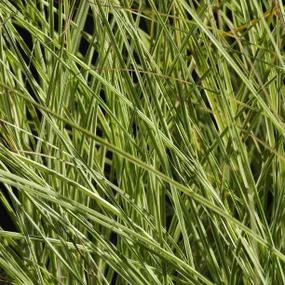Morning Light Eulalia Grass Plants
Honest Delivery PricesMiscanthus sinensis
- Deciduous grass
- Cream margins on narrow, pale green leaves
- Clump forming
- Long reddish flowers on head-high stems
- Suitable for low ornamental "hedge"
- Grows upright in full sun
- To 2m x 1.5m
Recommended extras
Description
Miscanthus sinensis 'Morning Light'. 2-Litre Pot-Grown Plants
Flowers are an occasional bonus with this graceful Chinese silver grass, whose clumps are narrow at the base, then spray out like a fountain.
The blades have cream margins that look great in the breeze, glowing pale green with hints of grey-white when the low sun shines through them - one of the best varieties for winter colour.
The ruddy flower tassels, when they do make an appearance, turn silvery white as they mature.
Browse all of our other grasses, or perennial plants.
Features
- Deciduous grass
- Cream margins on narrow, pale green leaves
- Clump forming
- Long reddish flowers on head-high stems
- Suitable for low ornamental "hedge"
- Grows upright in full sun
- RHS Award of Garden Merit
- To 2m x 1.5m
Growing 'Morning Light' Eulalia Grass
Grasses are tough and with a little help will establish almost anywhere there is some soil, so be brave with them as rockery features. Their favourite soil is fertile, moist and well drained, and full sun brings out their most upright habit. Plants grown in partial shade are fine, except they tend to flop.
Like any deciduous grass, they benefit from being sheared down to low mounds, every late Winter or early Spring to make way for new growth.
In Your Garden Design
It holds its shape really well, rather than collapsing in a soggy mess, and looks dramatic lining a path, so it's wonderful for using in an exposed coastal situation or in a "prairie" scheme, with perennials such as eupatorium, rudbeckias, asters, Verbena bonariensis and anemones.
Planting Instructions
Did You Know?
Miscanthus is from the Greek words mischos, stalk, and anthos, flower. The genus holds about 20 species, originating from Asia where it is good grazing and, less often these days, used for thatched roofs and children's toys made out of the tufty flower-heads.




